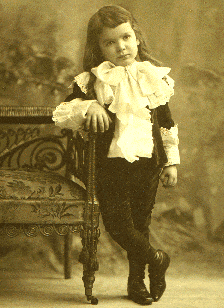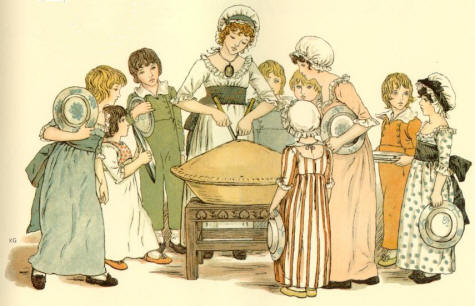Children's Vintage "Storybook" Fashions
(based on excerpts from The Child in Fashion)
Few ideas would have
seems more radical to the Victorians than the notion that clothing should be
comfortable. Men’s suits were fitted, their shirt collars starched rigidly
stiff. Ladies’ fashions varied were tight, often had awkward skirts, and
were worn beneath anything–but–practical underclothing. Even children’s
clothes were extravagant and irrational by modern standards—not merely
impractical for school and play, but very often influence by storybooks and
fairy tales, rather than by youngsters’ real lives and activates. Kate
Greenaway’s enchanting illustrations, the fictional Little Lord
Fauntleroy, even the comic strip Buster Brown—each had a profound impact
on what 19th and early 20th century children wore.
Probably no style has ever been loathed by
its wearers as deeply and universally as the Little Lord Fauntleroy outfits
of the late 19th century. The memoirs of men who grew up in that era are
studded with snarling recollections of being dressed in lace and velvet,
much against their will. The look was based on Reginald Birch’s
illustrations for the novel Little Lord Fauntleroy by Frances Hodgson
Burnett, now better known as the author of The Secret Garden and
The Little Princess.
Little Lord Fauntleroy appeared in
serial form in 1885, but boys didn’t feel the impact until the following
year, when it was published as an illustrated book in the United States and
England. The plot features an almost–unbearably sweet, yet manly, little
chap, born in America but heir to a British title, who softens the heart of
his lonely, embittered grandfather and resolves a long–standing family feud.
This shamelessly sentimental tale sold over a million copies in England
alone, was translated into 12 languages, and earned over $100,000 (about a
million of today’s dollars) during its author’s lifetime.

Burnett describes the little hero’s “soft,
fine, gold–colored hair, which curled up at the ends and went into loose
rings...big brown eyes and long eye–lashes and a darling little face...” In
the illustrations, Lord Fauntleroy’s hair falls to his shoulders and he’s
attired in a black or deep royal blue velvet jacket with knickerbockers,
worn with a white blouse with a large lace collar. A silk sash, silk
stockings, and buckled shoes completed the look, which was inspired by one
of Gainsborough’s most famous paintings, Blue Boy. Little did the author and
illustrator realize the misery they were creating for boys whose doting
mamas wanted them to look just like the young hero of the best–selling book.
This is one typical response, recalled many
years later: “That confounded Little Lord Fauntleroy craze, which led to my
being given as a party outfit the Little Lord Fauntleroy costume of black
velvet and Vandyke collar, was a curse. Naturally, the other boys were
inclined to giggle at my black velvet and after protesting in vain against
being made to wear it I decide to make it unwearable by flinging myself down
in the gutter on the way to dancing class and cutting the breeches,
incidentally severely grazing my own knees. I also managed to tear the
Vandyke collar. Thus not only did I avoid the dancing class, but I also
avoided being photographed in that infernal get–up.”
Even men too old to wear the style seem to
have hated it. One enraged gentleman wrote, “I saw a boy with an idiot of a
mother, wearing a silk hat, ruffled shirt, silver–buckled shoes, kid gloves,
cane and a velvet suit which is an insult to his sex.”
But Burnett and Birch didn’t invent the
look. In 1885, a year before the illustrated Little Lord Fauntleroy
appeared, a fashion magazines called The Lady described a suit that
sounded remarkably similar. The style predated the novel; the book’s success
just encouraged fanciful mamas to indulge themselves.
Equally influential were the works of
illustrator/writer Kate Greenaway. As an artist, she is best known for her
whimsical drawings of children in miniature versions of the costumes worn by
adults in the 1790s. One Victorian writer who had just attended a Greenaway
exhibit in London commented, “The old–world costume in which she usually
elects to cloth her characters lends an arch piquancy of contrast to their
innocent rites and ceremonies.”

During the 1880s—90s, many mothers found
these high–waisted, Empire–style fashions preferable to the more elaborate
girl’s clothing popular at the time. Dress reform journals were especially
quick to praise its simplicity and beauty. “Picturesque poke bonnets with
high, standing ends and loops in the back and a wreath of tiny flowers
across the front of the crown are worn by little girls,” the editors of
Dress wrote approvingly in 1888, when Kate Greenaway’s illustrations
first appeared.
Not everyone was equally enthusiastic. In
1893, The Young Ladies’ Journal said, “Opinions remain divided as to
the long skirts worn by the babies painted by Kate Greenaway. While some
mamas delight in the comical look which long skirts give their little ones,
other consider that nothing is more absurd and inconvenient for them than
such an imitation of ‘grown–up’ gowns, and that a little child is not made
to be dressed up like a doll.”
La Mode Illustree was particularly
sarcastic. This fashion journal wondered whether a child dressed a la
Greenaway was a “little girl or a dwarf—one hesitates before venturing an
opinion.” The style was described as having “trailing skirts ruffled a the
hem, short–waisted bodices with tucked yokes flanked by ruching, or large
shawl collars, crossed and ending in...streamers. Sash of draped fabric of
ribbon, placed barely under the arms and tied in a bow in back with long
tails...Immense hat in the form of a bonnet, with embroidery or lace all
around falling over the eyes and forming a curtain...Thus decked out, the
child [is] nothing more than a dreary caricature...Ladies” the magazine
concluded, “keep Kate Greenaway in her albums...”
Greenaway, who died in 1901, might have
pointed out that she was not a couturier but an artist; she never suggested
the clothes in her illustrations were meant to be worn by real children.
Furthermore, the same criticisms—“too grown–up,” “uncomfortable,”
“caricature–like”—could just as early describe the mainstream children’s
fashions of the period. Luckily, she had a keen sense of humor and happily
recounted the following incident in a letter to a friend: “I asked [a
certain lady] if her cousins were growing up as pretty as they promised.
‘Yes,’ she replied, ‘but they spoil their good looks, you know, by dressing
in that absurd Greenaway style’—quite forgetting that she was talking to
me."
Another unexpected, much less romantic,
source for children’s clothing came from a comic strip. “For the little boy,
there is no more becoming a suit than that termed the ‘Buster Brown,’” the
editors of The Delineator noted in 1901, when the comic strip of the
same name debuted in newspapers. With its tow–headed, mischievous hero, the
strip found almost immediate success. By 1908, the Buster Brown suit was
common garb for boys under 12: a suit with knee–length, belted jacket
trimmed with a stiff, flat white collar and a floppy black bow tie, topped
off by a wide–brimmed straw hat.

So whether mother’s fancied their children
as “darling little Lord Fauntleroys,” charming miniature Greenaway adults,
or slightly–naughty comic strip heroes, Victorian children often found
themselves in a strange realm between fantasy and fact—looking as thought
they just stepped out of the pages of a storybook.
(c) 2000 by Kristina Harris
04/21/2006